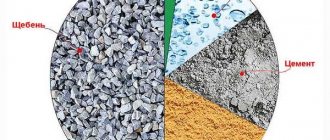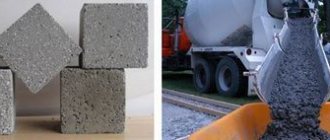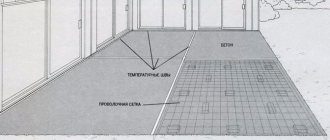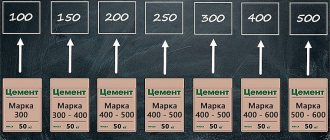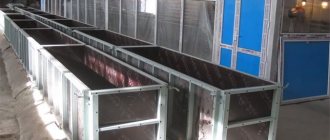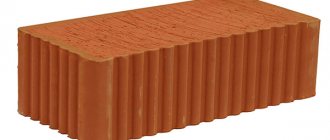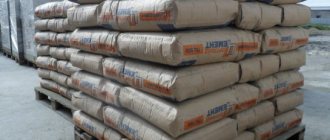Concrete is an important component of almost any job. The concreting stage is expected at the site under construction. This could be, for example, a foundation, ceilings, walls, floor, blind area. The needs of large-scale construction are met by ready-mix concrete produced by factories. Individual developers and owners of private houses prefer to prepare the solution themselves, saving money in this way. If the industrial method guarantees product quality control, then private owners themselves need to ensure the correct proportions of the components, compliance with the sequence of mixing and pouring the mixture. The desired result in concreting can only be achieved by strictly following the instructions and technological diagrams.
Components and proportions
The concrete mixture is always prepared on the basis of 4 components. This:
- cement;
- sand;
- water;
- coarse aggregate.
All proportions are based on cement. In this case, an important indicator is its brand. For example, for some types of concrete it is enough to use M400 binder, while for others it is necessary to use M500 or Portland slag cement.
The basic ratio, often used in practice, is C:P:SH:W = 1:3:5:0.5. For example, to prepare a mixture based on 100 kg of binder, you need to add 300 kg of sand, 500 kg of crushed stone and 50 liters of water. For those who prefer to mix concrete with their own hands, it will be easier to determine the number of components “in buckets”. In this case, we talk about accuracy only conditionally. For 1 bucket of binder, take 2 buckets of sand, 3 of crushed stone and approximately half a bucket of water.
You can calculate the ingredients for any volume. Professionals say that to obtain 1 m³ of concrete mixture of different brands, you need to take the exact volume of cement. The table will show this data. Accordingly, the amount of crushed stone, sand and water is then determined based on the ratios for the required grade.
| Brand | Cement, kg |
| M100 | 167 |
| M200 | 241 |
| M250 | 300 |
| M300 | 320 |
| M350 | 370 |
| M400 | 417 |
| M450 | 470 |
About 10% of concrete is cement. Aggregates account for 80-85%. There are 2 types of them: fine- and coarse-grained. The role of the filler is to form and create a rigid concrete “skeleton” that reduces shrinkage and prevents the formation of cracks and chips in the structure.
The fine aggregate is sand. It must be as free from impurities as possible. The river one is most valued. The quarry may contain impurities (loams, lumps of clay). Owners of private households do not always comply with the requirements for the purity of sand and allow contaminated material to be poured into the mixing container. In the nearest ravine, forest or on the river bank, they collect sand in buckets and, without sifting it, send it to a concrete mixer. As a rule, the finished composition contains “foreign bodies”, such as grass stems, plant roots, and soil.
As for the coarse filler, several options are allowed here: crushed stone, gravel, screenings, broken brick, crushed pieces of hardened concrete.
The use of each of the listed types is regulated by the type of work. For rough pouring, broken pieces of concrete and crushed brick are quite suitable as filler. When performing finishing concreting, crushed stone (5-20 mm), gravel and screenings should be added.
Proportion on proportion
Each grade of cement has its own proportions to get the grade of concrete you need. So, to prepare M200 concrete from M400 cement, the proportions should be as follows: 1 part cement, 2.8 parts sand and 4.8 parts crushed stone. In this recipe, as in subsequent ones, the mass ratios of materials are indicated.
M250 concrete proportions:
- 1 part cement,
- 2.1 parts sand
- and 3.9 parts of crushed stone.
With this proportion, from 10 liters of cement you will get 43 liters of concrete.
Mixer for solution
M300 concrete can be prepared from M400 cement; the proportions of the materials are as follows: as before, 1 part cement, 1.9 parts sand and 3.7 parts crushed stone. The proportions of M500 concrete assume a high cement content, which determines the high strength of this brand of concrete. In general, this brand of concrete is used quite rarely. Yes, and according to the passport it is called concrete M550, but among the people the name M500 has firmly established itself behind it for unknown reasons.
Features when mixing
Good concrete should be of medium thickness. If the proportions are not observed, it can burst, be insufficiently strong, crumble, and so on. So, if there is a large amount of cement, it will simply “tear” when setting. Excess sand leads to deterioration in quality. The solution must envelop all the crushed stone, otherwise the product will not be durable. At the same time, if there is a lack of crushed stone and an excess of solution, it will burst.
Concrete of any quality is afraid of frost. If you have to fill it in the cold season, then you need to add special mixtures that prevent the water in it from freezing. Otherwise, with the onset of spring, it will begin to peel and flake off. The sun is no less harmful. When exposed to sunlight, the surface of the product dries too quickly and may crack.
The solution must be well mixed. Its components must be loaded into the concrete mixer in a certain sequence. First, water is poured into it. The amount of water should be slightly less than normal. After this, half the crushed stone and all the concrete are loaded. After a short period of time - all the sand. Next, the remaining crushed stone and the remaining amount of water are loaded. Thanks to this loading sequence, all components are mixed well, and the cement itself does not stick.
Where is it used?
Concrete of this grade is used for the construction of bridges, hydraulic structures, reinforced concrete structures, dams, dams and other structures with increased requirements. It is made only from granite crushed stone using the highest grade of cement.
I would also like to say something about the crushed stone fraction. To ensure high-quality concrete of any brand, you need to use crushed stone with a grain size of 5-20 mm. Sand for concrete should be as clean as possible and free from all impurities in the form of silt, clay or limestone; screenings can also be used.
When preparing a cement mixture, try to ensure that the cement completely absorbs the water so that it is not in a free state. Then your concrete structure will be durable and will serve you for many years.
Composition of concrete. General concepts.
It seems that our distant ancestors had knowledge of the proportions of the concrete mixture, and if the storytellers had paid more attention not to ideology, but to technology, then calculating the concrete mixture would not have presented much of a problem. The basis for this assumption is a fairy tale, which tells how the owner fed the worker several times, first with meat, then with porridge, and at the end, after giving him wine, he could not stand it and asked: “How did it happen that after each dish you said , that you’re full, and also drank a good liter of wine?” To which the worker responded very figuratively, namely: he brought a bucket, filled it with stones to the brim and asked: “Is this bucket full?” “Yes,” answered the owner. Then the worker brought sand, poured it into a bucket and asked: “Is this bucket full?” “Yes,” answered the owner. Then the worker brought water, poured it into a bucket and asked: “Is this bucket full now?” “Yes,” answered the owner. Unfortunately, the authors of the tale omitted cement, did not indicate the fraction of crushed stone and, in general, the proportions of the components, so now each time they have to calculate the composition of the concrete mixture.
Heavy concrete usually means “structural concrete with cement binders, dense aggregates, dense structure, natural hardening.” It is this kind of concrete that is usually mixed at the construction site to pour the foundation, tension belt, monolithic floor slab or lintels. The composition of the concrete mixture for the preparation of heavy concrete includes 4 main components: cement (C) - binder, water (W) - binder, sand (P) - fine aggregate, crushed stone (S) or gravel (G) - coarse aggregate. All that is needed is to determine the amount of each component in the future concrete and this is not so difficult to do, the main thing is to understand why each of the components is needed, and why so much attention is paid to the proportions of the components.
Concrete is an artificial stone that must have the qualities required by design calculations. One of the main qualities of concrete is strength, or more precisely, the calculated compressive strength. The composition of concrete includes natural stones - crushed stone or gravel, obtained by mining and processing rocks - large aggregates. They just provide the necessary margin of safety. In other words, the greater the strength of the crushed stone grains, the greater the overall strength of the concrete. All other components - cement, water and sand - are needed in order to properly bind the grains of crushed stone and thus obtain a monolithic structure. Thus, concrete resembles masonry with cement-sand mortar (and historically, concrete appeared as a result of the improvement of masonry). At the same time, the cement-sand mortar must also have a certain strength in order to ensure the required strength of concrete.
After mixing with water, cement gradually forms an artificial stone. This process takes a very long time, and people don’t like to wait for a long time, so when making concrete, you should take into account when the concrete should reach its design strength. Most often, concrete is calculated for design strength at the age of 28 days, but sometimes, if there is no great rush, then the concrete mixture can be calculated taking into account the fact that design strength will be achieved after 90 or even 180 days. In these cases, less cement will be required.
Many types of cements used in civil engineering are shrinkage cements, i.e. The volume of cement stone will decrease over time and the cement stone will crack. To minimize the formation of cracks and thereby increase the strength of the cement stone, fine aggregate - sand - is added.
In addition to the above components, the composition of concrete may include various types of mineral or chemical additives to provide other required qualities, for example, frost resistance or heat resistance. The amount of these additives should also be taken into account when calculating the concrete mixture.
One of the most important qualities of a concrete mixture is workability. The more plastic the mixture, the easier it will be to lay and compact it, and the less likely it will be to have air voids, which significantly reduce the overall strength of the concrete. Workability depends on the composition and properties of the aggregates, but the higher the water content, the better the workability. However, if there is too much water, the mixture will delaminate, which means the resulting concrete will be very heterogeneous and the overall strength of the concrete will be less than the design strength. The minimum amount of water required to provide the required workability is called water requirement.
There is a classification of concrete mixtures depending on workability. According to GOST 7473-94 “Concrete mixtures. Technical specifications" concrete mixtures are divided into three main groups: mobile (P), rigid (ZH) and super-rigid (SZh). When preparing a concrete mixture at a construction site, there is no point in using hard and super-hard mixtures; flexible mixtures are quite sufficient. Each group is further subdivided into brands. For mobile mixtures, the following grades are accepted for workability with the corresponding cone draft:
Table 256.2. Grades for workability (according to GOST 7473-94)
Cone settlement means how many centimeters the concrete mixture will settle some time after removing the cone. For testing in factory and laboratory conditions, a special standard cone is used, the dimensions of which must comply with GOST 10181.1-81 “Concrete mixtures. Methods for determining workability." A standard cone should have an upper diameter of ~10 cm, a lower diameter of ~20 cm, a height of ~30 cm and special handles for easy removal. And there is also an enlarged cone. However, in the conditions of a construction site there is no need for such precise instruments, and if it is really necessary to approximately determine the draft of the cone, then you can use an ordinary metal bucket without a bottom. To do this, the prepared concrete mixture is poured in three batches into an inverted bucket placed on a metal sheet so that the bucket is adjacent to the sheet as closely as possible, each layer of the mixture is compacted, then the bucket is carefully removed and the cone settlement is determined.
Since both crushed stone and sand can have different grain sizes, moreover, the shape of the grains rarely approaches the correct geometric, and the aggregate grains have different roughness, needle-likeness, flakiness, etc., then the amount of cement required to To firmly bind these grains, different quantities are required. Moreover, crushed stone and sand are almost never perfectly clean, and for obvious technological reasons they have a certain amount of impurities. The more such impurities there are, the worse the adhesion of the grains will be and therefore more cement will be required with a large amount of impurities.
As a result, the proportions of water, cement, crushed stone and sand (W: C: S: P) should be determined, taking into account the above factors. The accumulated practical experience and theoretical developments allow us to do this quite accurately. Scientists and engineers who have been studying the properties of concrete for decades have compiled various tables and graphs that allow calculations to be made quite simply and quickly. As an example, table 256.1.
Now consider the following situation:
At the construction site there is a concrete mixer - a gravity concrete mixer, with a tank volume of -140 liters, a volume of the finished mixture of 70 liters, cement in bags that has lain for more than a year from the date of manufacture, sand, crushed stone with a maximum grain size of about 40 mm, buckets, shovels
Dosing of components will be done not by weight, but by volume; a 10-liter bucket will be used as a dispenser.
It is required to fill a lintel with concrete 3 m long, 0.4 meters wide and 0.21 m high. The volume of reinforcement will be 3.14x0.0182x4x4/4 = 0.0041 m3. Then the volume of concrete for such a lintel will be 3x0.4x0.21 - 0.04 = 0.248 ≈ 0.25 m3. If transverse reinforcement and structural reinforcement of the top layer are also used, then even less concrete will be required, but we will not go into details so deeply. The calculation determined the required class of concrete for the B25 lintel, as well as the working reinforcement - 4 rods d = 18 mm. The details of formwork and reinforcement placement are not discussed here, it is assumed that all this has already been done.
Application
Concrete B 30 of such a popular grade as 400 is used where increased reliability and frost resistance are of paramount importance:
- In the production of beams and piles.
- During the construction of pools and foundations.
- When constructing a bank vault and buildings that require increased reliability and water resistance.
- During the construction of a bridge and interchange.
That is, this concrete is widely used in industry. Especially when constructing swimming pools or foundations for cottages.
